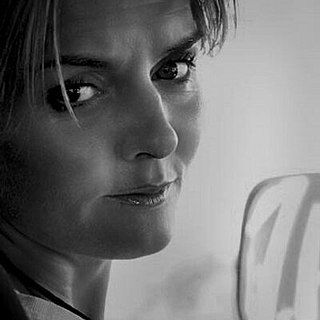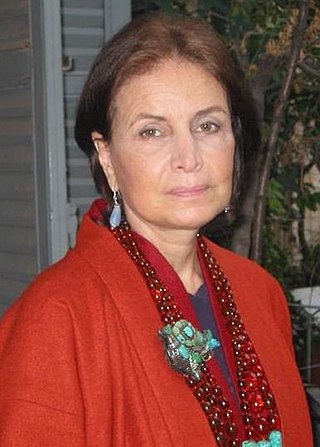Related Research Articles

MENA, an acronym in the English language, refers to a grouping of countries situated in and around the Middle East and North Africa. It is also known as WANA, SWANA, or NAWA, which alternatively refers to the Middle East as Western Asia, this is another way to reference the geographical region, instead of using the more common political terminology.

Martine Franck was a British-Belgian documentary and portrait photographer. She was a member of Magnum Photos for over 32 years. Franck was the second wife of Henri Cartier-Bresson and co-founder and president of the Henri Cartier-Bresson Foundation.
African Photography Encounters is a biennial exhibition in Bamako, Mali, held since 1994. The exhibition, featuring exhibits by contemporary African photographers, is spread over several Bamako cultural centers, including the National Museum, the National Library, the Modibo Keïta memorial, and the District Museum. The exhibition also features colloquia and film showings. The most recent biennial took place in 2017.

The roles of women in the Arab world have changed throughout history, as the culture and society in which they live has undergone significant transformations. Historically, as well as presently, the situation of women differs greatly between Arabic speaking regions, their urban or rural population and age groups. Among other factors, these differences can be attributed to local traditions, culture and religion, women's social or legal status, their level of education, health or self-awareness. Since the 19th century, and notably through the influence of the colonization in North Africa, the Arab Renaissance in Egypt, Lebanon, and Syria, and the end of the Ottoman Empire, the social and economic changes in the Arab world have become greatly accelerated and diversified.

Fatma Samba Diouf Samoura is a Senegalese former diplomat and senior executive. She was appointed as the first female Secretary General of FIFA by President Gianni Infantino on 13 May 2016 and assumed her post on 20 June 2016. Previously she worked in various positions at the United Nations. In 2018, Forbes ranked her Number 1 in their Most Powerful Women in International Sports list, and the BBC listed her as one of their 100 women.
Corinne Dufka is an American photojournalist, human rights researcher, criminal investigator, and social worker. She is the recipient of a MacArthur "genius grant" Fellowship.

Katherine Emily Holt is a British photojournalist, who works primarily across Africa and the Middle East to gather humanitarian and development stories for NGOs and private companies, as well as the UK and global media. She is also the director of communications agency, Arete.
Lucas Dolega, born Loucas von Zabiensky-Mebrouk and also called Lucas Mebrouk Dolega, was a French/German photojournalist. He was reportedly killed by Tunisian police while he was photographing a protest in Tunis. As reported in The Guardian (UK), Dolega was the first journalist killed during the 2010-2011 Tunisian protests, according to Reporters Without Borders. He was also the first journalist to die while on assignment during the Arab Spring uprisings.
Michael Tsegaye is an Ethiopian artist and photographer. Much of his work presents a glimpse of life in contemporary Ethiopia, although an extended catalogue of his images come from his travels abroad.

Camille Lepage was a French photojournalist who was killed during the conflict in the Central African Republic in 2014. Her death was described as a murder by the French presidency and it marked the first death of a Western journalist in the conflict.

Anna Margherita Cataldi was an Italian humanitarian, journalist, film producer, and author of several books.
Leila Alaoui was a French–Moroccan photographer and video artist. She worked as a commercial photographer for magazines and NGOs and completed assignments on refugees. Her work was exhibited widely and is held in the collection of Qatar Museums. Alaoui died from injuries suffered in a terrorist attack in Ouagadougou, Burkina Faso.

Françoise Huguier is a French photographer.
Hichem Driss is a Tunisian photographer, educated at the École de communication visuelle in Paris. A freelance photographer since 2002, he has often cooperated with other photographers within fashion, design, architecture and art photography. In his series #404, Driss deals with the sudden freedom from censorship in the wake of the Jasmine Revolution in 2011.
Helga Kohl is a photographer born in Poland and based in Namibia whose work explores abandoned diamond mine towns in Namibia. Her main series of buildings in Kolmanskop show how the Namib desert's sands have reclaimed abandoned buildings. She is a member of the Professional Photographers in Southern Africa (PPSA) and her works have been exhibited and collected internationally, though especially prominent in Namibia.

Mamia Chentouf (Arabic: ماميا شنتوف was an Algerian midwife, independence activist and founder of the first women's rights organization in Algeria. Encouraged by her family to become educated, she attended the University of Algiers and completed training as a midwife. During her schooling, she joined the Algerian Independence Movement, which sought to free the country from French colonial rule. Using her work as a midwife to make contacts with other women, she rallied them to the nationalist cause and founded the first women's rights organization in the country. As part of the militant group, she was exiled, arrested and then fled to Tunis, Tunisia in 1955. While living there, she was one of the founders of the Algerian Red Crescent Society. At the end of the Independence War she became a journalist, returned to Algiers and studied political science. She served as organizer of the National Union of Algerian Women and was successful in creating family planning centers. Frustrated at an inability to change the family code to prohibit polygamy, she retired from politics in 1969.
The ICRC Humanitarian Visa d'or Award has been awarded annually to a professional photojournalist who has covered a humanitarian issue related to an armed conflict since 2011. It is part of the annual Visa pour l’image international festival of photojournalism, which takes place in Perpignan, France. From 2011 to 2015, the ICRC Humanitarian Visa d'or Award rewarded a photojournalist who had worked on the issue of violence against health care services in armed conflict. From 2015 to 2017, the competition focused on the situation of women in war: sexual violence, women in detention, women looking for missing family members, female fighters or also women becoming single heads of household. In 2018, the contest's theme changed to tackle the consequences of urban warfare on civilians.

Photography in Sudan refers to both historical as well as to contemporary photographs taken in the cultural history of today's Republic of the Sudan. This includes the former territory of present-day South Sudan, as well as what was once Anglo-Egyptian Sudan, and some of the oldest photographs from the 1860s, taken during the Turkish-Egyptian rule (Turkiyya). As in other countries, the growing importance of photography for mass media like newspapers, as well as for amateur photographers has led to a wider photographic documentation and use of photographs in Sudan during the 20th century and beyond. In the 21st century, photography in Sudan has undergone important changes, mainly due to digital photography and distribution through social media and the Internet.
Fatoumata Diabaté is a Malian photographer from Bamako.
Mohamed Bourouissa is an Algeria-born French photographer, based in Paris. In 2020 Bourouissa won the Deutsche Börse Photography Foundation Prize. His work is held in the collection of the Maison européenne de la photographie, Paris.
References
- 1 2 3 4 "Zohra Bensemra". Reuters. Retrieved 26 June 2016.
- ↑ "Photographer notebook: Zohra Bensemra", Reuters Full Focus. Retrieved 9 April 2013.
- ↑ "Meet Zohra Bensemra: Reuters pictures are a work of art" Archived 2011-05-18 at the Wayback Machine , Thomson Reuters, 15 April 2011. Retrieved 9 April 2013.
- ↑ Bensemra, Zohra. "My Journey into Syria". Reuters. Archived from the original on 17 March 2012. Retrieved 26 June 2016.
- 1 2 "Rencontres de la photographie africaine 2005: Talent brut, Prix des Rencontres Africaines" Archived April 2, 2015, at the Wayback Machine , Photographie.com. (in French) Retrieved 9 April 2013.
- ↑ Fidler, Matt (21 December 2017). "From the agencies: Photographer of the year 2017: Zohra Bensemra". The Guardian . London. Retrieved 21 December 2017.
- ↑ "Zohra Bensemra, Algeria". www.unicef.de. 21 December 2017. Retrieved 4 June 2020.